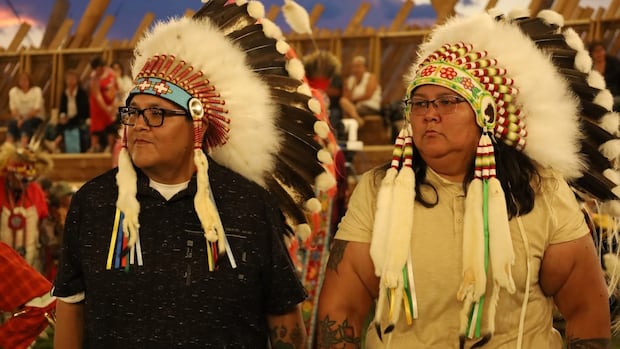IndigenousSome members of Muscowpetung Saulteaux Nation are looking to change the name of their nation based on information about the band’s original signatory to Treaty 4, Chief Cheekuk.New name would honour Chief Cheekuk, the nation’s signatory to Treaty 4 Darla Ponace · CBC News · Posted: Aug 21, 2025 7:18 PM EDT | Last Updated: 2 hours agoChief Cheekuk signed Treaty 4 on behalf of the community that is now known as Muscowpetung Saulteaux Nation. (Louise Bigeagle/CBC)Some members of the Muscowpetung Saulteaux Nation are looking to change the community’s name to Cheekuk Anishinaabe Nation after the community’s signatory to Treaty 4, Chief Cheekuk.”As a community, we’ve been discussing proper ways to honour our ancestors,” said Myke Agecoutay, chief operating officer of the Muscowpetung Saulteaux Business Development, who is an advocate for the name change.Agecoutay said the proposed change is about “really recognizing our Anishinaabe identity.”The idea came about after the Muscowpetung leadership was working on a strategic planning with a former chief of the Siksika Nation in 2021. The former Siksika chief asked them about their creation stories and history and Agecoutay said they had limited knowledge of their own history at the time.A year later, the community hired a research and analytical firm to look into Muscowpetung origins — and Chief Cheekuk. “They go through published documents in archives and they’ve been putting together a story that tells us clearly that Chief Cheekuk signed the treaty,” Agecoutay said. Treaty 4, also known as the Qu’Appelle Treaty, was signed September 15th, 1874 in Fort Qu’Appelle, Sask. and covers much of the southern part of the province. The Crown promised to provide annuity payments, farming equipment, allow hunting and fishing as well as provide on-reserve schools among other things. Agecoutay said Cheekuk signed after a year of being hesitant about Canada and the Crown’s words during negotiations. “He signed as a nation with legal standing within Treaty 4, and that’s why it’s important we honour that man. We all have treaty benefits today because of Chief Cheekuk’s signature.” Myke Agecoutay and Muscowpetung Saulteaux Chief Melissa Tavita stand during grand entry in the nation’s new arbour. (Submitted by Myke Agecoutay )After the passing of Cheekuk, Chief Muscowpetung assumed leadership of the community from 1880 to 1915. The First Nation was subsequently named in his honour.”This year 2025, being our 150th year of Treaty, it is important that we go back and honour that man who struck that for us and that’s Chief Cheekuk,” said Agecoutay.Indigenous Services Canada can receive official name change requests from First Nations through a band council resolution.Muscowpetung leadership is hoping to hold a naming ceremony and sign a resolution on Aug. 22 following a community discussion on the name change. Mixed opinions on name changeCBC Indigenous visited the community earlier this week and asked a few people about their thoughts on the name change.Community member Donna Okeeweehow said she hopes the band will keep its current name.”I’d like to see the naming of the new arbour to be named after Cheekuk in honour of him,” she said. Tim Rosebluff, a traditional powwow dancer from Muscowpetung Saulteaux Nation, also doesn’t agree with a name change.”I’ve been on reserve here for 56 years and it’d be hard to adjust to the name change in the years to come,” he said. Blair Stonechild says he would like to see the community renamed to honour Cheekuk. (Kendall Latimer/CBC)Blair Stonechild is an Indigenous studies professor at the First Nations University of Canada in Regina and a member of the Muscowpetung Saulteaux Nation. Stonechild said it was a surprise for many to learn their band wasn’t named after the Treaty 4 signatory and leader, and added that the name change would be a step toward reclaiming their identity.He said his own research into land claims and other issues has revealed the difficult history faced by the community in that era. “For example, the band was virtually forced to surrender the land through a process of starving them to submission in order to force them to surrender their land,” said Stonechild, adding that hay lands were also flooded which badly disrupted the local economy. “Changing the name would signify both the reclaim of our history, but it can also sort of mark a rebirth of renaissance.”ABOUT THE AUTHORDarla Ponace is a Saulteaux woman from Zagime Anishinabek First Nations. She started as an associate producer in the Indigenous Pathways program at CBC. She is currently working with CBC Saskatchewan as a reporter. You can email her at darla.ponace@cbc.ca with story ideas. With files from Louise Bigeagle
Monday, 22 Dec 2025
Canada – The Illusion
Search
Have an existing account?
Sign In
© 2022 Foxiz News Network. Ruby Design Company. All Rights Reserved.
You May also Like
- More News:
- history
- Standing Bear Network
- John Gonzalez
- ᐊᔭᐦᑊ ayahp — It happened
- Creation
- Beneath the Water
- Olympic gold medal
- Jim Thorpe
- type O blood
- the bringer of life
- Raven
- Wás’agi
- NoiseCat
- 'Sugarcane'
- The rivers still sing
- ᑲᓂᐸᐏᐟ ᒪᐢᑿ
- ᐅᑳᐤ okâw — We remember
- ᐊᓂᓈᐯᐃᐧᐣ aninâpêwin — Truth
- This is what it means to be human.
- Nokoma











